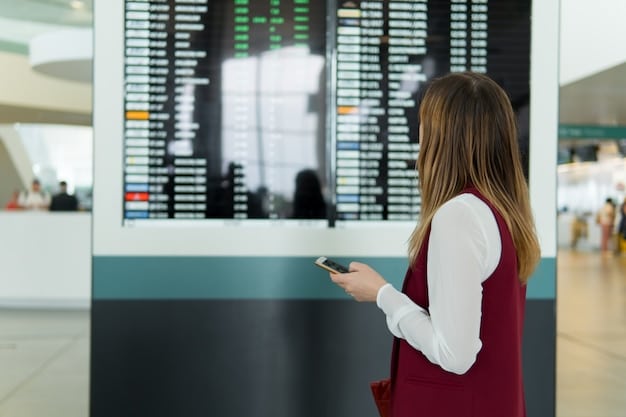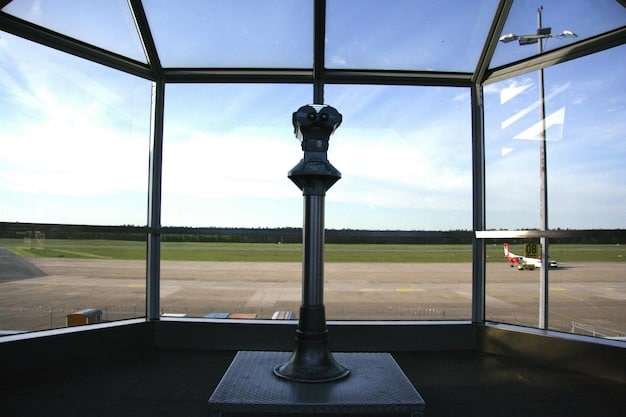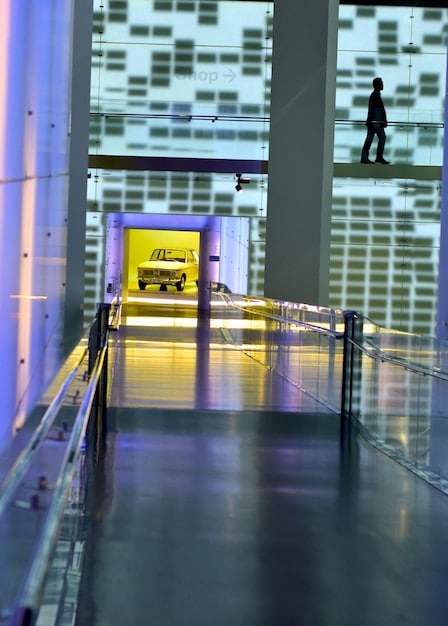US Govt to Invest $5 Billion in Airport Infrastructure Upgrades by 2025

The US government is set to allocate an unprecedented $5 billion for airport infrastructure upgrades by 2025, signaling a transformative investment aimed at modernizing facilities, enhancing operational efficiency, and improving passenger experience across the nation’s air travel network.
Air travel is more than just getting from point A to point B; it’s a critical component of economic growth, connecting communities and facilitating global commerce. The announcement that the US Government to Invest $5 Billion in Airport Infrastructure Upgrades by 2025 marks a pivotal moment for the future of air travel, promising a significant uplift in overall airport capabilities and passenger experience nationwide. This investment aims to not only modernize aging infrastructure but also to integrate advanced technologies, bolster safety, and ensure environmental sustainability.
The Imperative for Modernization: Why Now?
The United States’ airport infrastructure has long been a topic of debate, with many facilities struggling to keep pace with soaring passenger volumes and evolving technological demands. Decades of underinvestment have left some crucial hubs operating at or near capacity, leading to inefficiencies, delays, and a less-than-optimal travel experience for millions. The question often posed by industry experts and the traveling public alike has been: why aren’t our airports reflecting the innovation and efficiency seen in other sectors?
The answer is multifaceted, touching upon complex funding mechanisms, regulatory hurdles, and competing political priorities. However, the current administration’s commitment to injecting $5 billion into airport infrastructure upgrades by 2025 signifies a critical turning point. This infusion of capital is not merely about cosmetic changes; it’s a strategic move to address systemic challenges that have accumulated over years, hindering the nation’s aviation competitiveness on the global stage. It acknowledges that efficient airports are not just a convenience, but an economic necessity, supporting millions of jobs and billions in economic output.
Aging Infrastructure and Capacity Constraints
Many of the nation’s busiest airports were designed and built in an era when air travel was a luxury, not a mass transit system. Runways, terminals, and air traffic control towers, while functional, often lack the capacity and technological sophistication required to handle modern aircraft and the sheer volume of daily flights. This leads to bottlenecks, especially during peak travel seasons or adverse weather conditions, demonstrating a clear need for substantial upgrades.
- Increased passenger wait times at security checkpoints and gates.
- Overcrowded terminals with limited amenities and comfort.
- Outdated baggage handling systems prone to delays and errors.
- Runways and taxiways requiring frequent, costly maintenance.
These issues not only impact passenger satisfaction but also contribute to higher operational costs for airlines and air cargo carriers. The proposed investments seek to alleviate these pressures by expanding capacity, streamlining processes, and implementing smart technologies that can manage increased traffic more efficiently, from check-in to take-off and beyond.
Technological Advancements and Security Needs
The aviation landscape is constantly evolving, driven by rapid technological progress and ever-present security challenges. From biometrics and artificial intelligence to advanced air traffic management systems, the airport of tomorrow will look vastly different from today’s. Currently, many US airports are playing catch-up, trying to integrate these innovations into existing, often rigid, structures.
The $5 billion investment provides a golden opportunity to leapfrog some of these hurdles. It will enable airports to adopt cutting-edge security screening technologies that enhance safety without compromising efficiency, integrate seamless passenger processing systems, and upgrade air traffic control equipment to improve airspace utilization. Furthermore, future-proofing infrastructure against cyber threats and adopting sustainable energy solutions are increasingly vital considerations that this funding aims to address.
In essence, the timing for this investment couldn’t be more critical. It represents a proactive measure to ensure the US aviation system remains robust, resilient, and ready to meet the demands of the 21st century. By addressing foundational issues and embracing innovation, the government aims to transform the travel experience and solidify the nation’s position as a leader in global aviation.
Key Areas of Investment: Where Will the Money Go?
With a monumental $5 billion investment in airport infrastructure upgrades by 2025 on the horizon, understanding precisely where these funds will be channeled is crucial. This substantial allocation is designed to be comprehensive, tackling a range of identified deficiencies and fostering forward-looking development across the nation’s airport network. From enhancing passenger flow to bolstering operational resilience, each dollar aims to contribute to a more efficient, secure, and sustainable aviation ecosystem.
The federal government, in collaboration with airport authorities and stakeholders, will prioritize projects that demonstrate a clear return on investment, aligning with strategic national goals for air travel. This ensures that the funding is not merely dispersed widely but is instead targeted at improvements that yield significant benefits for both the traveling public and the aviation industry as a whole.
Terminal Modernization and Expansion
A significant portion of the funds is expected to be directed towards the revitalization and expansion of airport terminals. These are the primary touchpoints for passengers, and their condition directly impacts the overall travel experience. Modernizing terminals involves more than just aesthetics; it encompasses redesigning layouts to improve passenger flow, increasing the number of gates, and upgrading essential services.
Projects might include:
- Adding new concourses or expanding existing ones to accommodate more flights and passengers.
- Upgrading baggage claim areas with advanced, faster conveyor systems.
- Implementing biometric scanning and self-service kiosks to expedite check-in and security.
- Improving amenities such as lounge spaces, dining options, and retail facilities.
The goal is to transform crowded, often chaotic spaces into pleasant, efficient environments that cater to the needs of modern travelers, reducing stress and enhancing comfort. This also includes ensuring accessibility for travelers with disabilities, a critical aspect of inclusive design.
Runway and Airfield Improvements
While often unnoticed by passengers, the runways and airfields are the lifeblood of airport operations. Deteriorated runways can lead to flight delays, increased maintenance costs for airlines, and potential safety concerns. Investment in this area is fundamental for maintaining the integrity and capacity of the national airspace system.
Expected improvements cover:
- Repaving and strengthening existing runways and taxiways to support heavier aircraft.
- Expanding runway lengths for enhanced safety margins and diverse aircraft types.
- Installing advanced navigation aids and lighting systems for all-weather operations.
- Upgrading airfield drainage systems to prevent water accumulation and improve safety.
These enhancements are vital for ensuring the smooth and safe movement of aircraft, reducing congestion on the ground, and supporting the ever-increasing volume of flight operations. A well-maintained airfield translates directly into fewer delays and more reliable service for passengers.
Air Traffic Control Towers and Technology Upgrades
Modern air traffic control (ATC) systems are the brains of the aviation network, guiding aircraft safely through complex airspace. Many existing ATC facilities and their underlying technologies are aging, limiting their efficiency and responsiveness. A significant part of the $5 billion investment will therefore focus on upgrading these critical systems.
This includes:
- Constructing new, state-of-the-art ATC towers with improved visibility and operational space.
- Implementing next-generation air traffic management (NextGen) technologies, such as satellite-based navigation and digital communications.
- Upgrading radar systems and surveillance equipment for more precise tracking.
- Investing in advanced data analytics and predictive tools for better traffic flow management.

These technological advancements are crucial for handling the projected growth in air travel, improving safety margins, and reducing flight delays caused by airspace congestion. The combined focus on ground infrastructure, terminals, and air traffic management aims to create a truly integrated and high-performing national airport system.
Economic and Social Impacts: A Multiplier Effect
The US Government’s $5 billion investment in airport infrastructure upgrades by 2025 isn’t just about smoother take-offs and more comfortable waiting areas; it’s a strategically significant injection of capital set to deliver profound economic and social benefits across the nation. This level of investment acts as a powerful catalyst, creating a ripple effect that extends far beyond the airport perimeters, influencing job markets, local economies, and national competitiveness.
The long-term vision is clear: a modern, efficient air travel network is vital for a thriving economy. It facilitates business travel, supports tourism, and ensures the rapid movement of goods, all of which are indispensable for sustained growth and prosperity. The projected impacts are diverse, encompassing both direct and indirect benefits that will reshape communities and contribute to the national GDP.
Job Creation and Local Economic Growth
A funding injection of this magnitude directly translates into a significant boost for the construction and related industries. Infrastructure projects are labor-intensive, requiring a wide array of skilled workers, from engineers and construction managers to electricians and plumbers. This immediate surge in demand for labor will lead to substantial job creation opportunities, offering employment and income to thousands of Americans.
- Direct jobs: Construction workers, project managers, skilled tradespeople.
- Indirect jobs: Suppliers of materials, equipment manufacturers, logistics providers.
- Induced jobs: Increased spending by newly employed workers in local communities.
Moreover, these projects stimulate local economies by increasing demand for local businesses and services, from hotels and restaurants serving construction crews to suppliers providing essential materials. This economic stimulus is particularly valuable in regions where airports are major employers, acting as anchors for their communities.
Enhanced Connectivity and Tourism Boost
Upgraded airports mean more capacity, better efficiency, and potentially new routes. This enhanced connectivity directly benefits businesses seeking to expand their markets and travelers looking for easier access to destinations. For the tourism sector, modernized airports are a significant draw, making it more appealing for both domestic and international visitors to choose the US as a travel destination.
Improved airport facilities contribute to a positive first impression for tourists, encouraging longer stays and repeat visits. Easier and more efficient travel can also transform regional economies by making previously less accessible areas more viable for tourism and business investment. This, in turn, boosts local revenues from hospitality, retail, and other service industries.
Improved Efficiency and Business Competitiveness
For businesses, especially those reliant on air cargo or frequent executive travel, the efficiency of airport operations is paramount. Reductions in flight delays, faster baggage processing, and streamlined security procedures save companies valuable time and money. This improved efficiency makes US businesses more competitive on a global scale, facilitating faster supply chains and more responsive logistics.
Additionally, advanced infrastructure attracts businesses looking to establish or expand operations near well-connected hubs, creating a positive feedback loop of investment and growth. The overall impact is a more robust, agile, and interconnected national economy, capable of responding to the challenges and opportunities of the global marketplace.
The investment in airport infrastructure is thus a multifaceted strategy: it addresses pressing operational needs while simultaneously laying the groundwork for future economic expansion and social well-being nationwide.
Challenges and Hurdles: Navigating the Path to Modernization
While the announcement of the US Government’s $5 billion investment in airport infrastructure upgrades by 2025 is met with widespread optimism, the path to implementing these ambitious projects is fraught with complex challenges. Transforming vast, intricate airport ecosystems requires navigating a maze of regulatory, logistical, and financial hurdles. Understanding these obstacles is crucial for appreciating the scale of the undertaking and for anticipating potential delays or modifications to the grand vision.
The multifaceted nature of airport development means that coordination among various stakeholders—federal agencies, local airport authorities, airlines, and even local communities—is paramount. Each project, regardless of its size, interacts with a highly regulated environment and often involves sensitive community relations, adding layers of complexity to even seemingly straightforward upgrades.
Regulatory Approvals and Environmental Concerns
Airport expansion and modernization projects are subject to rigorous regulatory oversight from various federal agencies, notably the Federal Aviation Administration (FAA) and the Environmental Protection Agency (EPA). Obtaining the necessary permits and approvals can be a lengthy process, often involving extensive environmental impact assessments and public hearings. These procedures are critical for ensuring safety, compliance with environmental standards, and addressing community concerns, but they can significantly extend project timelines.
Key regulatory challenges include:
- Meeting stringent FAA safety and operational design standards.
- Complying with environmental regulations regarding noise pollution, air quality, and habitat preservation.
- Navigating complex land acquisition processes, especially in densely populated areas.
- Obtaining public consensus and addressing local community opposition to new construction or noise impacts.
Any unexpected findings during environmental assessments or strong community opposition can lead to redesigns, project delays, or even cancellations, underscoring the importance of thorough planning and public engagement from the outset.
Funding Allocation and Distribution
Although the $5 billion figure is substantial, its effective allocation across hundreds of varying-sized airports nationwide presents a significant logistical challenge. Deciding which projects receive funding and how much is a complex process, often involving competitive grant applications and detailed assessments of need and impact. Ensuring equitable distribution while maximizing overall system benefits requires sophisticated analytical frameworks and transparent decision-making.
- Developing transparent criteria for grant applications to ensure fairness and maximize impact.
- Balancing the needs of large international hubs with smaller regional airports.
- Managing cost overruns and ensuring projects stay within budget.
- Coordinating federal funding with state, local, and private sector contributions.
The challenge lies not just in securing the funding, but in deploying it strategically to achieve the desired outcomes without significant waste or inefficiency. This requires robust oversight mechanisms and accountability measures.
Supply Chain Disruptions and Labor Shortages
The current global economic climate presents further practical hurdles. Supply chain disruptions can delay the delivery of critical materials and equipment, from steel and concrete to advanced technological components. This can push back project timelines and increase costs, thereby challenging the ambitious 2025 completion target.
Simultaneously, the construction industry, like many others, faces skilled labor shortages. Recruiting and retaining enough qualified workers for large-scale, complex airport projects can be difficult, potentially slowing progress and driving up labor costs. These external factors, while not unique to airport projects, add an additional layer of complexity to the planning and execution phases.
Overcoming these challenges will require a combination of meticulous planning, proactive risk management, strong inter-agency coordination, and sustained collaboration with all stakeholders involved. The success of the investment hinges on addressing these hurdles effectively to ensure smooth, timely, and impactful upgrades.
Technological Integration: Smart Airports of the Future
The significant investment from the US Government to inject $5 billion into airport infrastructure upgrades by 2025 is not solely about bricks and mortar; a substantial portion is poised to catapult US airports into a new era of technological sophistication. The vision is to develop “smart airports” – hubs that leverage cutting-edge technology to enhance every aspect of operations, from security and passenger processing to energy efficiency and air traffic management. This integration of innovation is key to future-proofing facilities and ensuring they can handle projected growth while offering a seamless, personalized experience.
The transition to smart airports requires a strategic embrace of digital transformation, moving beyond fragmented systems to create interconnected, data-driven environments. This approach aims to not only address current inefficiencies but also to anticipate future needs, making airports more resilient, responsive, and resource-efficient.
Biometrics and Seamless Passenger Journeys
One of the most transformative areas of technological integration is the increased adoption of biometrics. Instead of repeatedly presenting passports and boarding passes, passengers will likely experience a much smoother journey using facial recognition or fingerprint scanning. This technology promises to significantly reduce wait times at check-in, security checkpoints, and boarding gates.
- Automated identity verification at multiple touchpoints.
- Reduced physical contact, enhancing hygiene and speed.
- Personalized information and services delivered proactively.
- Streamlined international arrivals and departures.
This seamless passage, from curb to gate, is designed to minimize stress and maximize efficiency, transforming the often-arduous airport experience into a more pleasant and predictable one. The focus is on creating a flow that is intuitive and reduces bottlenecks caused by manual processes.
AI, IoT, and Predictive Analytics for Operational Efficiency
The backbone of a smart airport lies in the ubiquitous deployment of the Internet of Things (IoT) devices, powered by artificial intelligence (AI) and predictive analytics. Sensors across the airport can monitor everything from baggage movement and passenger density to equipment performance and energy consumption. This massive influx of data, when analyzed by AI algorithms, provides real-time insights that can optimize operations.
Examples of applications include:
- Predictive maintenance for equipment like escalators, jet bridges, and baggage systems, reducing downtime.
- Dynamic allocation of resources (gates, staff) based on real-time flight schedules and passenger loads.
- Optimizing energy use in terminals through smart lighting and climate control systems.
- Enhanced security surveillance with AI-powered anomaly detection.

These intelligent systems allow airport operators to make data-driven decisions that improve efficiency, reduce operational costs, and enhance safety. They transform airports from static structures into responsive, adaptive environments that can better manage disruptions and optimize passenger flow.
Enhanced Ground Transportation Integration
A truly smart airport extends its reach beyond the terminal walls to include integrated ground transportation solutions. This involves leveraging technology to improve access and connectivity, whether it’s through improved public transport links, smart parking systems, or seamless integration with ride-sharing services. Future airports will likely feature sophisticated apps and digital signage that guide travelers efficiently from their arrival point to their departure gate, encompassing all modes of transport.
Technology like real-time traffic monitoring, predictive parking availability, and demand-responsive shuttle services can significantly reduce congestion on airport roads and improve accessibility for all travelers. This holistic approach ensures that the “smart” experience begins long before a passenger even enters the terminal building, contributing to an overall more efficient and enjoyable journey.
Sustainability and Resilience: Building for the Future
Beyond the immediate goals of modernization and efficiency, a critical component of the US Government’s $5 billion investment in airport infrastructure upgrades by 2025 is a strong emphasis on sustainability and resilience. Recognizing the long-term impacts of climate change and the need for environmentally responsible operations, these new projects aim to incorporate green building practices, renewable energy sources, and robust designs that can withstand future environmental challenges. The goal is to create airports that are not only efficient and modern but also environmentally conscious and adaptable.
This commitment to sustainability is driven by a combination of factors: increasing public demand for greener infrastructure, the economic benefits of energy efficiency, and a recognition of aviation’s role in global climate efforts. Future airport upgrades will set a new standard for responsible development within the transportation sector, balancing growth with environmental stewardship.
Energy Efficiency and Renewable Energy Adoption
A significant focus will be on reducing the carbon footprint of airport operations through enhanced energy efficiency and the increased adoption of renewable energy sources. Airports consume vast amounts of energy, making them prime candidates for innovative solutions that can significantly lower operational costs and environmental impact. This is not just about installing solar panels; it’s about a holistic approach to energy management.
Key initiatives include:
- Installing solar power arrays on terminal rooftops and unused land.
- Implementing advanced LED lighting systems and smart building controls that adjust based on occupancy and natural light.
- Upgrading HVAC systems for optimal energy consumption and improved air quality.
- Exploring geothermal heating and cooling systems for major facilities.
The aim is to move toward net-zero energy buildings and operations where feasible, leading to substantial long-term savings and a reduced reliance on fossil fuels. This contributes directly to national climate goals and positions airports as leaders in sustainable infrastructure.
Water Conservation and Waste Management
Sustainable airport development also extends to responsible water usage and comprehensive waste management strategies. Airports, with their large numbers of daily users, can place a significant strain on local water resources, and generate considerable waste. New investments will target solutions that minimize these impacts.
This will involve:
- Implementing rainwater harvesting systems for irrigation and non-potable uses.
- Installing low-flow fixtures in restrooms and kitchens to reduce water consumption.
- Developing advanced waste sorting and recycling programs, potentially including composting facilities.
- Exploring waste-to-energy technologies where appropriate.
By effectively managing water and waste, airports can reduce their environmental footprint, conserve valuable resources, and demonstrate a commitment to ecological responsibility. These efforts align with broader circular economy principles, maximizing resource efficiency.
Climate Resilience and Future-Proofing
Building for the future also means building to withstand the impacts of a changing climate. Airports are critical infrastructure and must be resilient to extreme weather events such as increased flooding, stronger winds, and rising sea levels. The upgrades will incorporate design elements and technologies that enhance their ability to endure and recover from such events.
Resilience measures may include:
- Elevating critical infrastructure in flood-prone areas.
- Designing buildings and hangars to withstand higher wind loads.
- Implementing advanced drainage systems to manage heavier rainfall.
- Investing in robust backup power systems and redundant operational networks.
By proactively integrating climate resilience into design and construction, the $5 billion investment helps protect these vital transportation hubs, ensuring continuous operation even in the face of environmental challenges. This forward-thinking approach secures the long-term viability and functionality of the nation’s air travel network.
The Path Forward: What to Expect by 2025 and Beyond
The commitment of the US Government to invest $5 billion in airport infrastructure upgrades by 2025 sets a clear trajectory for the future of air travel in the United States. This substantial financial injection is not a one-off solution but a foundational step in a broader, ongoing effort to modernize and future-proof the nation’s aviation system. What travelers and stakeholders can anticipate by the mid-decade and in the years that follow is a gradual yet significant transformation of the airport experience, marked by enhanced efficiency, improved comfort, and increased sustainability.
The journey from announcement to tangible results involves meticulous planning, phased implementation, and continuous adaptation to emerging needs and technologies. It represents a long-term vision that extends beyond 2025, laying the groundwork for a more resilient, technologically advanced, and environmentally responsible aviation network.
Immediate Impact and Phased Rollout
By 2025, specific projects funded by this initiative will be underway or reaching completion across numerous airports. Travelers will likely begin to notice improvements in key areas first. These initial enhancements will pave the way for larger, more complex transformations in the years that follow. The federal funding will often serve to kickstart projects that require additional state, local, or private investment, acting as a catalyst for broader development.
Early visible changes might include:
- Faster security screening lanes due to new technology installations.
- Refurbished gates and lounge areas offering more comfortable waiting spaces.
- More efficient baggage handling systems, reducing wait times for checked luggage.
- Digital signage and improved wayfinding systems for better passenger navigation.
These initial improvements are designed to demonstrate tangible progress and build momentum for the deeper, more systemic changes that will take longer to realize. They also aim to alleviate some of the most pressing pain points experienced by travelers today.
Long-Term Vision for US Airports
Looking beyond 2025, the vision for US airports is one of fully integrated, smart, and sustainable transportation hubs. The current investment is expected to facilitate a shift towards a national airport system that is not only highly efficient but also adaptable to future demands, including unforeseen technological advancements or changes in travel patterns. The long-term goals are ambitious, aiming to position US airports at the forefront of global aviation.
Future developments anticipated include:
- Greater automation of airport processes, from passenger services to baggage handling.
- Seamless multi-modal transportation integration, connecting air travel with high-speed rail and urban transit.
- Nearly real-time data sharing across the aviation ecosystem to optimize all aspects of operations.
- Widespread adoption of renewable energy, moving towards net-zero carbon operations.
This comprehensive approach ensures that the investments made today will continue to yield benefits for decades to come, creating airports that are not just points of transit but vibrant centers of economic activity and innovation.
Collaboration and Ongoing Investment Needs
The success of this and future modernization efforts hinges on continued collaboration among all stakeholders: federal agencies, airport authorities, airlines, and local communities. The $5 billion injection is a significant start, but ongoing investment will be critical to maintain momentum and address evolving needs. Public-private partnerships are likely to play an increasingly important role in funding future phases of development, leveraging both government resources and private sector expertise and capital.
The collective commitment to a modern, efficient, and resilient air travel infrastructure is paramount. As the projects unfold, it will be vital to monitor their progress, assess their impact, and adapt strategies to ensure the US aviation system remains one of the safest, most efficient, and most sustainable in the world. The journey to a fully transformed airport experience has begun, and the coming years promise a remarkable evolution.
| Key Point | Brief Description |
|---|---|
| ✈️ Fund Allocation | The US government will invest $5 billion into airport infrastructure upgrades by 2025. |
| 🏗️ Upgrade Focus | Key areas include terminal modernization, runway improvements, and air traffic control technology. |
| 💰 Economic Impact | Expected to create jobs, boost local economies, and enhance US business competitiveness. |
| 💡 Tech Integration | A push towards smart airports with biometrics, AI, and IoT for seamless operations and efficiency. |
Frequently Asked Questions
The US government has announced a substantial allocation of $5 billion specifically for airport infrastructure upgrades. This significant investment is earmarked for various projects aimed at modernizing facilities, enhancing operational efficiency, and transforming the overall travel experience for passengers across the nation by the target year.
The investment is strategically aimed at several critical areas. Key beneficiaries are expected to include terminal modernization and expansion, improvements to runways and airfields, and significant upgrades to air traffic control towers and their underlying technologies. These areas have been identified as crucial for improving capacity, safety, and efficiency.
This $5 billion investment is anticipated to have a substantial multiplier effect on the US economy. It is expected to create numerous jobs in the construction and related industries, stimulate local economic growth in communities surrounding airports, enhance connectivity for businesses, and boost the tourism sector by offering more appealing and efficient travel hubs.
Technology is a central pillar of the modernization efforts. The aim is to create “smart airports” through the integration of biometrics for seamless passenger journeys, AI and IoT for real-time operational efficiency, and enhanced ground transportation integration. These technological advancements are designed to streamline processes, increase security, and improve overall passenger flow.
Yes, significant challenges are expected. These include navigating complex regulatory approvals and environmental concerns, ensuring equitable and efficient funding allocation across diverse airports, and mitigating potential issues related to global supply chain disruptions and ongoing labor shortages within the construction industry. Overcoming these hurdles will require extensive coordination and strategic planning.
Conclusion
The commitment by the US Government to invest an astounding $5 billion in airport infrastructure upgrades by 2025 signals a transformative era for air travel in the United States. This strategic allocation transcends mere facility enhancements, aiming to fundamentally reshape the passenger experience, bolster national economic competitiveness, and integrate cutting-edge technologies. While the path to modernization presents inherent challenges, the long-term vision of a more resilient, efficient, and technologically advanced aviation network is clear. This investment lays critical groundwork for a future where US airports are not just gateways, but exemplary models of innovation, sustainability, and seamless connectivity on the global stage.





